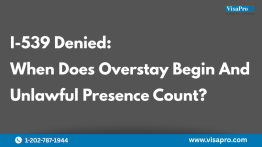Quick Summary:
Let’s say, you’re a doctor visiting the U.S. on a B-2 tourist visa. You’ve passed USMLE Step 1 and 2, and now you’ve discovered prep classes can help you pursue Step 3 and eventually specialize in the U.S. But how do you legally switch from B-2 to F-1? This guide explains your options, risks, and how to improve your chances of a successful status change, without violating your visa stay.
Changing Status From B-2 To F-1: A Real Option But With Conditions
Yes, you may apply for a change of status from B-2 to F-1 while in the U.S., but approval depends on strict documentation, timing, and USCIS discretion.
This route is commonly pursued by aspiring international students, including medical professionals, who realize the value of U.S.-based education. If you file the change of status (COS) request before your B-2 stay expires, you may remain in the U.S. until USCIS decides. But you cannot begin your classes until the change of status is approved.
Key Tip: Apply well before your I-94 expires and never start studying until your status officially changes to F-1.
Why Many Visitors On B-2 Want To Switch To F-1
Medical professionals, for example, often switch from B-2 to F-1 when they discover study opportunities unavailable in their home country, especially for USMLE Step 3 prep.
For many like you, a doctor already in the U.S. on a B-2 visa for tourism, the discovery of world-class resources in the U.S. designed to help test-takers tackle the USMLE can be life-changing. These are not easily accessible or equivalent in many countries. The F-1 student visa allows lawful study and may open long-term immigration pathways (e.g., residency through H-1B or J-1).
Example:
Dr. Aisha from Egypt visited the U.S. to explore residency options and ended up touring a test prep center. She applied for a change of status from B-2 to F-1 with strong financial documents and an I-20 from the school. Her F-1 was approved in less than 2 months with Premium Processing and she never had to depart the U.S.
The B2 To F1 Change Of Status Process: Step-By-Step
To convert B1 B2 visa to F1, you must first get accepted into a SEVP-approved school, receive an I-20, and then submit Form I-539 to USCIS before your I-94 expires.
Here’s what you’ll need:
Step-by-Step Checklist:
- Get Acceptance & I-20: Enroll in a SEVP-certified school and get a Form I-20.
- Prove Financial Ability: Bank statements, affidavits of support, and/or scholarships covering tuition and living expenses.
- File Form I-539: Submit this to USCIS along with the I-20, B-2 status proof, and supporting documents.
- Avoid Unauthorized Study: You cannot attend classes until approval.
- Wait Lawfully: If you apply before your B-2 status expires, you can stay in the U.S. legally while your application is pending.
Case Scenario:
Dr. Rakesh from India filed Form I-539 two weeks before his B-2 stay expired. USCIS took 7 months to decide, but he remained in the U.S. in “authorized stay” while waiting. His F-1 status was approved, and he started the prep classes soon after.

How To Increase Approval Chances For B1/B2 Visa Status Change To F1
USCIS scrutinizes intent and documentation. The more compelling and well-prepared your case, the higher your chances of approval.
Here’s how to strengthen your change of status B2 to F1 application:
What To Include:
- Strong Personal Statement: Explain why the program is essential to your career and include information about availability in your country.
- Detailed Timeline: Prove your plan wasn’t pre-conceived before entering the U.S. on B-2.
- Clear Nonimmigrant Intent: Emphasize you don’t intend to immigrate permanently and will follow visa rules.
- Program Details: Provide a curriculum outline, objectives, and end goals related to your program of study.
Example:
Dr. Lin from China was initially denied because her application lacked evidence of financial support. On reapplication with immigration attorney assistance, she included her clear documentation regarding her financial ability to pay for the educational program and living expenses while in the U.S. She also included her medical credentials, a study plan, and a personal letter from her home hospital supporting her U.S. training. Her B-2 to F-1 change of status was approved.
What Happens If USCIS Takes Longer Than Your B-2 Stay?
If you file before your I-94 expires, you may remain in the U.S. in authorized stay while waiting, but unauthorized study is prohibited until approval.
This is known as “authorized stay” under 8 CFR § 248.1. If you filed late or your application is denied, however, you could find yourself out of status and accruing unlawful presence. Additionally, you risk losing your B-1/B-2 visa completely.
Avoid These Mistakes:
- Do not overstay your I-94 before applying.
- Do not attend classes until F-1 is approved.
- Do not leave the U.S. while your application is pending unless you intend to abandon your application.
Real Case Example:
Dr. Mahmood filed for B2 to F1 change of status but started classes before approval. His F-1 was approved. However, his later application for change of status to J-1 was denied when the unauthorized study later came to light. He had to leave the U.S. and reapply from abroad with no guarantees that the consulate would issue the visa because of the serious status violation.
Do You Need To Leave The U.S. And Re-Enter?
No, if you apply for the change of status properly and on time, you don’t need to leave the U.S. You may remain while USCIS processes your case.
But if your B2 to F1 change of status is denied, or if processing delays interfere with study plans, you may need to depart the U.S. and apply for an F-1 visa at a U.S. consulate. This is common for those who:
- Have travel plans before approval
- Missed their B-2 expiry deadline
- Need to begin classes urgently
Tip: If you’re near your I-94 expiry and the institution’s session starts soon, ask an immigration lawyer if consular processing might be faster or better than COS.
What Happens If The Change Of Status Is Denied?
If your B-2 status has already expired, you must prepare to leave the U.S. immediately or explore other legal options like filing a motion to reopen (if you think the denial was not warranted). If your B-2 status has not expired, you can consider reapplying, or changing to another status. You can also leave the country to try to obtain the F-1 visa at a U.S. consulate.
Common reasons for B2 to F1 change of status denied:
- Poor documentation
- Suspected visa fraud or immigrant intent
- Unauthorized study before approval
- Late application filing
Example:
Dr. Tanya from Nigeria applied 10 days after she entered the U.S. on a B-2 visa. Despite having financial support and an I-20, USCIS denied her request as it became evident, she came to the U.S. with the sole intention of filing the F-1 change of status. She had to leave and apply from her home country.
Final Thoughts: Don’t Navigate This Alone
Changing status from B-2 to F-1 is possible, but nuanced. As a medical professional, your path is too valuable to risk on assumptions or incomplete paperwork.
VisaPro top immigration lawyers helped countless physicians and students successfully switch from visitor to student status. Whether you’re still considering prep classes, facing urgent deadlines, or unsure how to explain your case, we can guide you.
Ready for expert help? Schedule your free F-1 visa strategy session with VisaPro today.
FAQs: B-2 to F-1 Visa Change of Status
1.Can I change my B2 visa to F1 visa in the USA?
Yes, you can file Form I-539 for change of status B2 to F1 while in the U.S. If approved, you can begin studies without leaving the country. You must apply before your I-94 expires.
2.How long does it take for a B1/B2 to F1 change of status to be approved?
Processing times vary, but typically take 4 to 8 months. Timely filing allows you to remain in the U.S. during the wait, but you cannot start studying until you receive approval. With Premium Processing for the Form I-539 change of status to F-1, the processing time is reduced to 30 business days.
3.What are the chances of B2 to F1 change of status approved?
Chances are higher with strong documentation, financial proof, and a clear study plan. Each case is decided on its own merits, so legal guidance improves approval odds.
4.What happens if my change of status B2 to F1 is denied?
If denied, you must stop studying and leave the U.S. or explore other legal options. Accruing unlawful presence can harm future visa applications.
5.Can I convert B1/B2 visa to F1 for USMLE prep?
Yes, if the school is SEVP-certified and you receive an I-20, you may apply to convert B1/B2 visa to F1. Your case must demonstrate academic intent after entry, and also financial capability.
Need help making your U.S. study goals a reality?
VisaPro’s team of immigration lawyers is here to guide your journey every step of the way. Reach out today for a free strategy session.
What VisaPro Customers Are Saying
The US [B-1] Visa has always been a tough ride, and being denied a few times it makes it even worse. But thanks to VisaPro and their meticulous processing I was granted a Visa. I would like to thank you and all the people involved in making this a success. I would like to recommend VisaPro to all those who seek peace of mind and hassle free Visa processing.”




 Manas Bhat, Director Operations, First Houston Mortgage India
Manas Bhat, Director Operations, First Houston Mortgage India


